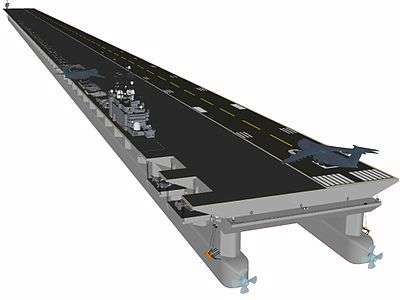Mobile offshore base

Mobile Offshore Base (MOB), sometimes called a Joint Mobile Offshore Base (JMOB), is a concept for supporting military operations beyond the home shores, where conventional land bases are not available, by deploying on the high seas or in coastal waters, in-theater multipurpose floating base assembled from individual platforms. In essence, a MOB is a multipurpose modular self-propelled floating platform, or several interconnected platforms, that can perform multiple functions of a sea base including strike, deployment and logistics. An ocean-wise semi-submersible wave and wind resistant platform capable to move at one-half the speed of conventional prepositioning monohull cargo ship has been researched and proposed, but never built.
Concept
Mobile Offshore Base concept emerged during a search for less cost effective option of sustaining in-theater strike, flight, maintenance, supply and other forward logistics support needs compared with utilizing traditional joint logistics approaches including nuclear-powered aircraft carriers and Large Medium Speed Roll-on/Roll-off (LMSR) sealift ships. MOB modules were projected as semi-submersible units having significantly smaller wave-induced motions compared to conventional hulls.[1]
In theory, the modularity of a MOB allows the full spectrum of air support, ranging from vertical/short takeoff and landing (VSTOL) aircraft using a single platform to conventional takeoff and landing (CTOL) aircraft utilizing several serially aligned modules approaching 2 km (6,000 feet) in length. The cluster could have an air strip that could hold a large aircraft such as C-130 or C-17. In addition, a MOB accepts ship-borne cargo, provides nominally 280,000 m² (3 million square feet) for equipment storage and maintenance, stores 40 million litres (10 million gallons) of fuel, houses up to 3,000 troops (an Army heavy brigade), and discharges resources to the shore via a variety of landing craft. It was argued, that once positioned, the MOB would operate as a sea base for an extended period, so it would need to have port-like facilities for unloading and loading conventional container and Roll-on/Roll-off ships.[2]
History
The idea of the MOB was first seriously considered when the United States entered Operation Desert Shield (1990–91). The U.S. was forced to request the use of allied bases, which, besides strictly military considerations, proved to be politically sensitive in the case of Saudi Arabia. With the MOB concept the U.S. could have a base anywhere in the world in as little as a month. The base as conceived would have had virtually unlimited capabilities, and most of its creators did not envision just a floating air strip, but a town-sized base.[3]
The Joint Mobile Offshore Base (JMOB) was a MOB concept for expeditionary warfare and humanitarian and commercial operations developed in the 1990s by McDermott International, Inc. of Arlington, Virginia. The JMOB was to be composed of five self-propelled units creating a one-mile long runway that could accommodate a fully loaded C-17. NATO was thought to be interested in the concept at the time.[4]
A technical report presented to the U.S. Congress in April 2000 identified that such a base was technologically feasible and could be built by the defense industry of the United States.
Criticism
In December 1999, the Office of Naval Research (ONR) in response to a congressional mandate issued a report which delineated the impracticality of MOBs, "the largest floating offshore structure ever conceived by maritime engineers",[5] on the grounds of high cost and vulnerability to threats such as missile attack. In January 2001, the Institute for Defense Analyses (IDA) stated that MOB "would not be capable of effectively replacing conventional sealift"[5] because it provides an inferior delivery capability to the existing Joint Logistics Over the Shore (JLOTS) system. The report concluded that the estimated US$5 billion to US$8 billion MOB project was less cost effective than existing at the time other solutions.[6][7]
In popular culture
- In the video game Command & Conquer: Red Alert 3, the Empire faction has multiple mobile offshore bases that it deploys to stage forces beyond its home shores. One of them is called the Black Tortoise.
- Tom Clancy's EndWar mentions the concept by name, using it explain the player's ability to seamlessly deploy troops across the Atlantic Ocean. One of the maps has the battle take place onboard USS Reagan, still under construction at the time, and at least a kilometer long.
See also
- Military logistics
- Military power projection
- Seabasing
- Unsinkable aircraft carrier
- Very large floating structure
- Floating airport
- Supercarrier
References
- ↑ Battle Island Popular Mechanics, April 2003, pp. 92-95.
- ↑ "Cargo Container Transfer Requirements for the Mobile Offshore Base" (PDF). National Institute of Standards and Technology. 1998-04-01. Retrieved 2006-06-18.
- ↑ Greer, W. (January 2001). "Mobile Offshore Base Operational Utility and Cost Study". Defense Technical Information Center. Institute for Defense Analyses.
- ↑ Wilson, Jim (2003), "Military Joint Mobile Offshore Base", Cover story in Popular Mechanics, April issue. Archived January 9, 2010, at the Wayback Machine.
- 1 2 Paul Nagy. Setting the Record Straight On Mobile Offshore Bases, National Defense, August 2001.
- ↑ "Mobile Offshore Base". GlobalSecurity.org. Retrieved 2006-06-18.
- ↑ "Mobile Offshore Base Operational Utility and Cost Study". Retrieved 2016-03-20.
Further reading
- MOB in Mansour, A E, and Rifat C. Ertekin. Proceedings of the 15th International Ship and Offshore Structures Congress. Oxford: Elsevier, 2003, p. 167-169.
- Greer, W. L. Mobile Offshore Base Operational Utility and Cost Study (No. IDA-P-3573). Alexandria, Va.: Institute for Defence Analysis, January 2001.
External links
- Mobile Offshore Base, GlobalSecurity.org